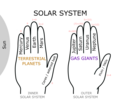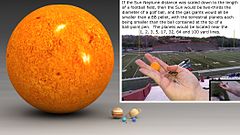File:Solar System Hand Mnemonic.png
Appearance

Size of this preview: 672 × 600 pixels. Other resolutions: 269 × 240 pixels | 538 × 480 pixels | 860 × 768 pixels | 1,147 × 1,024 pixels | 2,294 × 2,048 pixels | 2,800 × 2,500 pixels.
Original file (2,800 × 2,500 pixels, file size: 309 KB, MIME type: image/png)
File history
Click on a date/time to view the file as it appeared at that time.
| Date/Time | Thumbnail | Dimensions | User | Comment | |
|---|---|---|---|---|---|
| current | 22:49, 9 January 2013 |  | 2,800 × 2,500 (309 KB) | Tdadamemd | Reloading latest edit with moon count. |
| 11:29, 9 January 2013 |  | 2,800 × 2,500 (309 KB) | Tdadamemd | Listed in red are the number of moons for each planet and dwarf planet. Each is broken out into two sets, with the first being the number of large moons that have been rounded by hydrostatic equilibrium, and the second number is the remainder of known ... | |
| 08:35, 9 January 2013 |  | 2,800 × 2,500 (292 KB) | Tdadamemd | Identifying the left hand as representing the inner solar system, and the right hand as the outer solar system. | |
| 08:03, 9 January 2013 |  | 2,800 × 2,500 (277 KB) | Tdadamemd | Changing '&' to '/', because the previous notation seemed to indicate that Ceres was not part of the asteroid belt and that Pluto was not a TNO. | |
| 08:03, 7 January 2013 |  | 2,800 × 2,500 (280 KB) | Tdadamemd | User created page with UploadWizard |
File usage
The following page uses this file:
Global file usage
The following other wikis use this file:
- Usage on id.wikipedia.org

